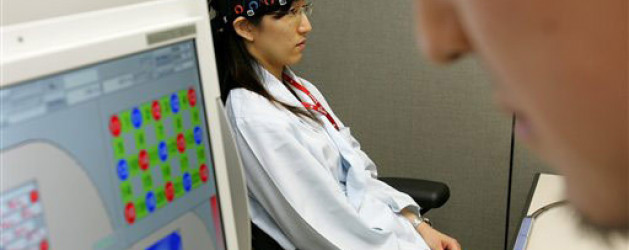Hitachi has been working on the development of a brain control device that will allow traumatic brain and spinal cord injury patients flexibility in their everyday life.The original hardware for a device that utilizes this technique was developed by Hitachi, and it allows a person with locked-in syndrome to say “yes” or “no.”
Allowing the user to forget the TV remote clicker and control electronic devices without lifting a finger simply by reading brain activity.The “brain-machine interface” developed by Hitachi Inc. analyzes slight changes in the brain’s blood flow and translates brain motion into electric signals.
A cap connects by optical fibers to a mapping device, which links, in turn, to a toy train set via a control computer and motor during one recent demonstration at Hitachi’s Advanced Research Laboratory in Hatoyama, just outside Tokyo.
A researcher, demonstrated the device by telling a reporter to take a deep breath and relax. At his prompting, a reporter did simple calculations in her head, and the train sprang forward — apparently indicating activity in the brain’s frontal cortex, which handles problem solving.
Activating that region of the brain — by doing sums or singing a song — is what makes the train run, according to the researcher. When the user stops the calculations, the train also stops. Hitachi’s scientists are set to develop a brain TV remote controller letting users turn a TV on and off or switch channels by only thinking. The technology could one day replace remote controls and keyboards and perhaps help disabled people operate electric wheelchairs, beds or artificial limbs.
Although brain-machine interface technology has traditionally focused on medical uses, makers like Hitachi and Japanese automaker Honda Motor Co. have been racing to refine the technology for commercial application. Honda, whose interface monitors the brain with an MRI machine like those used in hospitals, is keen to apply the interface to intelligent, next-generation automobiles.
Underlying Hitachi’s brain-machine interface is a technology called optical topography, which sends a small amount of infrared light through the brain’s surface to map out changes in blood flow. Initial uses would be helping people with paralyzing diseases communicate even after they have lost all control of their muscles.
Since 2005, Hitachi has sold a device based on optical topography that monitors brain activity in paralyzed patients so they can answer simple questions, for example, by doing mental calculations to indicate “yes” or thinking of nothing in particular to indicate “no.”
“We are thinking of various kinds of applications,” project leader Hideaki Koizumi said. “Locked-in patients can speak to other people by using this kind of brain machine interface.”
A key advantage to Hitachi’s technology is that sensors don’t have to physically enter the brain. Earlier technologies developed by U.S. companies like Neural Signals Inc. required implanting a chip under the skull.
Still, major stumbling blocks remain.
Size is one issue, though Hitachi has developed a prototype compact headband and mapping machine that together weigh only about two pounds. Japanese electronics giant Hitachi has unveiled a proto-type model of a portable brain-machine interface lately. This portable brain-machine interface is equipped with eight pairs of lasers and optical sensors in a special headband (weighting 400gram to 630gram) to measure prefrontal cortex activity. It senses activity from the user’s brain and converts it into signals to control electronic devices. It’s pretty cool!
In fact Hitachi demonstrated an early prototype in November last year. The device enabled users to turn on/off the power switch with a thought. It was very unique but the design of the headset was a bit old-fashioned. This latest brain-machine interface selling at US$840,000 which is shown at Hitachi’s headquarters in Tokyo represents an enormous leap forward compared to the previous version. Hitachi says the system is easy to use and that it has been built using parts from models designed for medical applications.
Another would be to tweak the interface to more accurately pick up on the correct signals while ignoring background brain activity.
Any brain-machine interface device for widespread use would be “a little further down the road,” Koizumi said.

